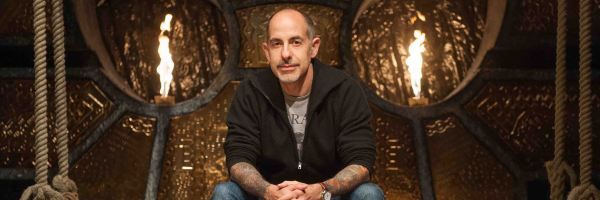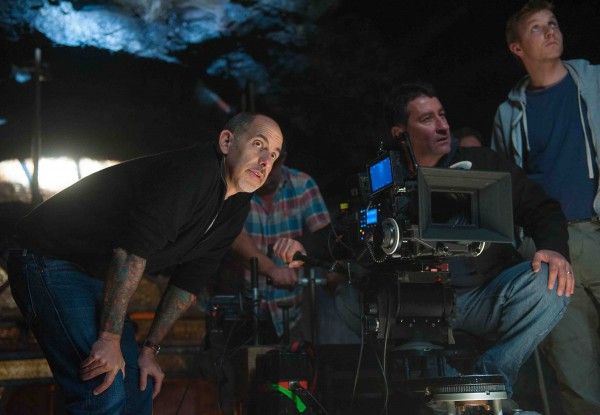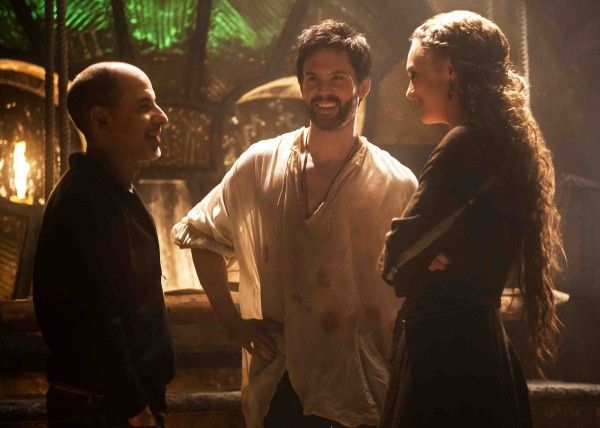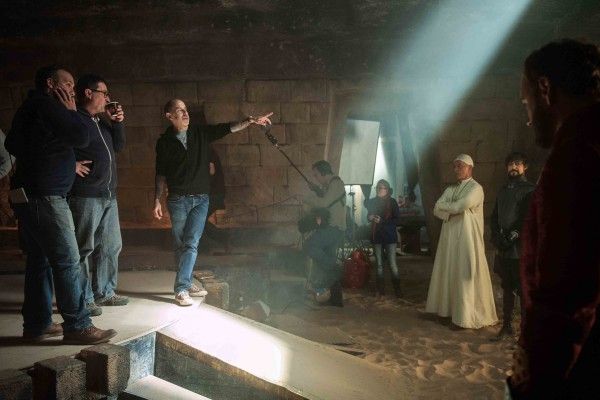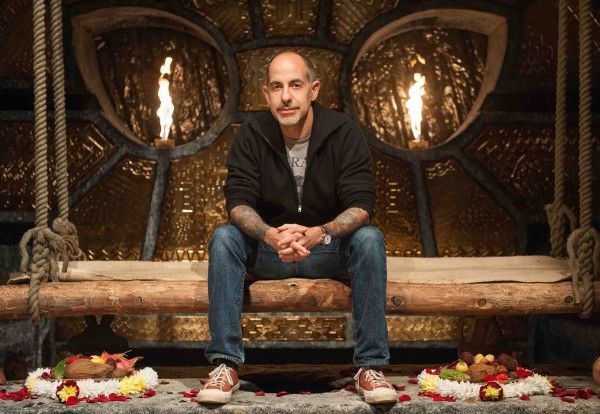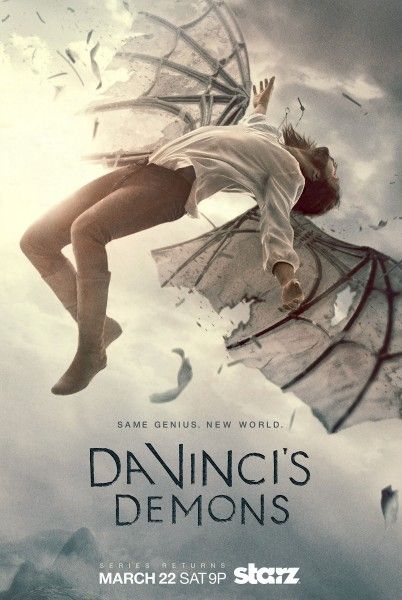The Starz original series Da Vinci’s Demons is back for Season 2, as Florence, Italy is thrown into chaos. Leonardo da Vinci (Tom Riley) must push the limits of his mind and body to defend the city against the forces of Rome while also continuing on his quest to faraway lands to find the fabled Book of Leaves.
During this recent exclusive interview with Collider, show creator David S. Goyer talked about how he always knew he’d be opening the scope of the story so much more for Season 2, that he finds himself drawing from both history and fantasy for the story they’re telling, how challenging it is to do big crowd scenes, teaming up Leonardo da Vinci with Riario, how many seasons he sees the show going, writing to the actors’ strengths, the portrayal of women and minorities, the addition of Amerigo Vespucci as a character, and only being able to direct some second unit this season. He also talked about the difficulty and pressure of making sure such iconic characters all get their due, in writing the Batman vs. Superman movie. Check out what he had to say after the jump, and be aware that there are some spoilers.
Collider: Did you always know that you were going to open the scope of the story so much more for Season 2?
DAVID S. GOYER: I did. Starz was nervous. I told them, at the beginning, that this show is going to go all over the world. Originally, in the first season, we ended Episode 2 with revealing this map of South America. Starz has been a great partner. They wanted me to end the first season that way, in Episode 8 and not Episode 2. I wanted to let the audience know, really early on, that this show is going to be crazy and it’s going to go all over the place. It’s the secret history of the world, and it’s not just about da Vinci. So, when it came time to do Season 2, I said, “We promised the audience that we’re going to take them on this crazy journey and physically go to other continents, so we have to make good on that promise.” There was a lot of anxiety about whether we could pull off South America in Wales, but we did it. The other thing I wanted to do was to start the first episode six months later, even though we ended on a cliffhanger, and just have the audience go, “What?! How did we get there?!” We also didn’t film just in Wales, this season. One of the nice things about doing a second season is that we had our standing sets, and then we had money to build new sets and do other things.
How long will you take before you return to that point, in the first episode, and show how that plays out?
GOYER: We will catch up to that scene and go beyond it, and it’s not in the 10th episode. You don’t have to wait the whole season to get there, but it is a bit further down the line.
You had the idea to go bigger, but did you also have ideas for specifics in Season 2?
GOYER: A little bit. I think that happens with a lot of shows. I think a lot of creators keep some of their really big ambitions close to their chest. I remember talking to Damon [Lindelof] about Lost, and they said to ABC, “Oh, don’t worry. There’s not going to be anything crazy about the show. It’s just going to be about the characters and their lives.” But he knew, all along, that they were going to get really crazy. I knew we were going to get crazier with this show, as well. I think Season 2 is a good statement of intent for what the show is going to be like, from here on out, to a certain extent.
As you get deeper into this story, do you find yourself drawing more from history or more from fantasy?
GOYER: Both. One of the things that’s fun is that there are a lot of things in Season 2 that were inspired by history. Even Leonardo going to the New World was inspired by these stories that the Chinese might have been in the Americas in the 13th or 14th century. Just because the story we’ve been told is that Columbus reached this continent at this time, it doesn’t mean there weren’t people that arrived earlier. All of that stuff is really intriguing to me.
Since there isn’t a lot of historical record about Leonardo da Vinci, what sort of feedback do you get from people who watch the show? Do you get less criticism for historical accuracy because of that?
GOYER: We were expecting some of that in the first season, and we got some guff from people saying, “Well, that wasn’t exactly historically accurate,” at the very beginning. But as the show progressed, a lot of that went away. Near the end of the season, we really weren’t getting any of that. And I don’t expect to get much of that, this season. This is not a docu-drama about Leonardo da Vinci. This is a historical fantasy. A lot of stuff is based on and inspired by fact, but I’ve never made any bones about the fact that we’re inventing some things.
How challenging was it to do the big crowd scenes this season?
GOYER: It’s hard. You learn what you’re good at, and then you try to stretch the boundaries and go even further. At any given point, we might have had 150 extras, which is the most we ever had in one place. If you see more extras than that, the rest are CG people. We call them sprites. We build CG people that we can use to populate. So, when you see thousands of people, the first 100 or 150 are real and the rest are CG. I like some of the crowd scenes in the second and third episodes.
Were you always looking to team up Leonardo and Riario, in some way?
GOYER: Yeah, that was definitely always the plan. I like it when adversaries are throw together and forced to work together against an even greater threat. I think that’s really fun.
Do you know how many seasons it will take you to tell this story? With all of the projects you’re working on, at any given time, do you have to really think about that?
GOYER: Yeah, of course. I like to multi-task. So far, I’ve been able to keep all of the plates spinning. In my mind, if we were fortunate enough to go there, it’s roughly about six seasons. I have a basic idea for how the whole show would end. And I have a pretty good idea, if we get there, for what Season 3 would be, and there are some grey areas in between. As you go further along, you have to think about it. You have to think a lot more about, if we were to go beyond this season, where will Season 4 and Season 5 end up. I have a pretty good idea of who lives and who dies, by the end of the whole show.
When you’re writing, do you think about the actors that you’re writing for?
GOYER: I know the actors really well, and I know their strengths and weaknesses and what they’re good at. One of the things that’s refreshing about doing the second season of a television show is that you can really write to the strengths of your actors. With the first season, we were all getting to know each other. I hadn’t worked with any of those people before. I thought they were all good actors, but I didn’t really know them very well. For the second season, I know them quite well and that feedback is fun, as you get deeper and deeper and deeper into a series. Some shows just get better and better and better because it’s like a musical ensemble working together, where everyone knows everyone’s strengths. There are great pilots, but it takes a season for a show to find its voice. Even though I’m really proud of what we did in the first season, I definitely feel that with Season 2, we hit the ground running, found our voice and were a lot more comfortable. There’s a lot of set-up in the first season, and then you can shed some more light, in the second season, on characters that didn’t get as much attention.
How much fun was it to have Tom Riley do the impression of Riario?
GOYER: We never would have thought of that, other than the fact that we were on the set in the first season and Tom was jokingly doing impressions of Riario, and we decided to write it into the script. That’s a perfect example of that feedback. We just thought it would be funny.
How does the portrayal of women change and evolve, this season?
GOYER: We’re cognizant of the fact that women, in that era, were either a nun or a whore or this Clarice-like character that was in this ivory palace. They were considered second-class citizens. So, one of the sub-themes of this show has always been is how minorities in that world were mis-perceived and underestimated. There’s a character named Carlo that you’ll meet in Episode 3, who’s a black guy that’s based on a historical figure. The first season was pretty white because all of those characters were Caucasian, but we learned about him. He shows up in a line or two in history. So, we get a bit more into the way black people were treated, at the time, and the way women were treated, at the time. One of the other sub-themes is that we start talking more about the Ottoman Empire and the Turks. We are going to meet some of them, later on in the second season. They’re an existential threat that we briefly talk about in the first season, and they’re off in the distance, slowly expanding. We’ll go to Constantinople in this season, as well. The other interesting thing about Season 2 is that we’re introducing some new series regulars, some of which you don’t see until Episode 8 or 9.
How much fun was it to bring in Amerigo Vespucci?
GOYER: I love Amerigo! That’s a perfect example of me being vaguely aware of Amerigo Vespucci. He’s the guy who named America. America is named after him. I thought he was some Christopher Columbus-like explore, but we did some research on him and he sounded like a scoundrel and a self-promoter, and he may not have discovered all of the things that he supposedly discovered, and he did work for the Medici. You read about all of that and you think that he sounds like an interesting guy. It’s fun to have that wink and nod with history.
Did you get to direct any episodes in Season 2?
GOYER: I only directed some second unit this season. In the first season, I directed a lot. I directed a few days of second unit. I’ve got some bits and bobs in some of the episodes. I was not able to get over there this season, physically, as much as I was with the first season.
When you’re writing something like the Batman vs. Superman movie, how difficult is it and how much pressure do you have to give characters like that their due and make sure everything is balanced?
GOYER: I always try my best to honor every character. When you’re dealing with big iconic characters, there’s a lot of fan pressure to get it right, and I respect that and admire that passion enormously. At the same time, you can’t let your creative process be too crowded by that or distracted by it. It’s not always one uniform opinion of how you should portray this character or that character. I think I’ve done a pretty good job of walking that razor’s edge. You just have to do your best and know what’s out there, but at the same time, follow your own muse.
Da Vinci’s Demons airs on Saturday nights on Starz.

